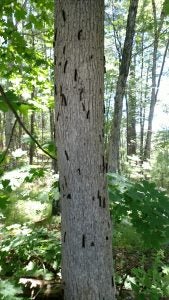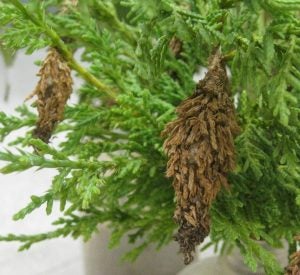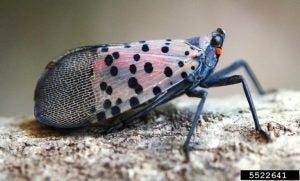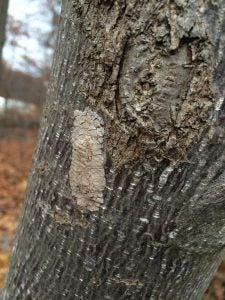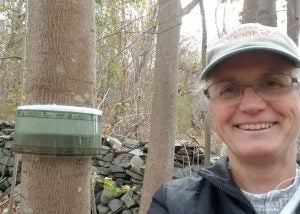Caterpillar update, November 2019
November 18, 2019
I’ve set up winter moth tree wraps at 3 locations this month. In past years, when winter moth populations were high, I set up tree wraps in as many as 13 locations. Tree wraps cause winter moth females to pause below the wrap and deposit eggs before continuing up the tree. In the spring I monitor these eggs to see when they hatch. The terrific news is winter moth populations have decreased dramatically, so it’s difficult to find areas with enough winter moths to monitor! Winter moth populations have decreased due to releasing a parasitic fly, Cyzenis albicans, from 2011-2017, as well as an increase of native predators and parasitic insects. It’s all very exciting!
Winter moths emerge from the soil from around Thanksgiving to Christmas. Moths you’ve seen flying for the past few weeks are likely a native, closely related moth – bruce spanworm.
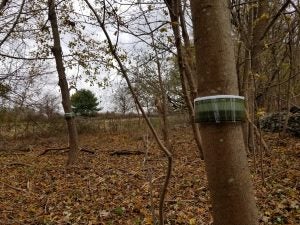
Tree bands set up in Portsmouth. Two other RI locations with tree bands are Kingston and Charlestown.
Gypsy moth caterpillars caused very little defoliation or damage this past spring. There were a few pockets of high gypsy moth populations in Burrillville, but I’m happy to report that wet weather in June allowed the fungus, Entomophaga maimaiga, to kill most gypsy moth caterpillars. Not as impressive as the big epizootic event of 2017, but still a beautiful sight!
Dead gypsy moth caterpillars in Burrillville June 26, 2019.
A different caterpillar has been increasing for the past several years. It’s not a forest defoliator, but it can defoliate landscape evergreens such as arborvitae, junipers, and spruce. It’s bagworm. Bagworms are native to more southern states and they didn’t use to overwinter here. Now they do. What tends to limit bagworm populations is cold weather in September and October. Cold weather in early fall kills bagworm caterpillars or limits the number of eggs bagworm females produce. September and October have been very balmy for the last several years, and recently more and more bagworms have survived. I think there may be a very large population of bagworms in 2020 due to our very warm September and October.
Bagworms are fairly easy to manage with a Bt (Bacillus thuringiensis) in July. Bt insecticides affect only caterpillars so it’s a good insecticide choice. If bagworm populations aren’t found until August or September, the caterpillars will be too large and won’t be successfully controlled by a Bt insecticide.
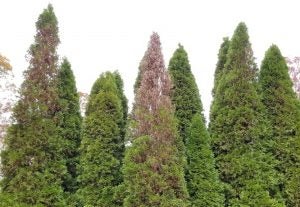
Bagworm cases
Another insect you should know about is not a caterpillar, but a planthopper. It’s spotted lanternfly (SLF). It’s not in RI yet, but it has been spotted in Sudbury, CT. Spotted lanternfly was first found in PA in 2014 and has since spread to surrounding states: NJ, DE, MD, VA and WV with sightings in NY, CT and MA. Spotted lanternfly can feed on many plant species and be pests to apple trees, stone fruits, grapes, hops, hardwoods, and many ornamentals. In areas of Pennsylvania where populations have exploded, SLF is a serious nuisance pest due to its tendency to congregate in large numbers.
Adult SLF are large (~ 1 inch) and conspicuous. Egg masses, the overwintering stage, are not nearly as noticeable. For more information see https://web.uri.edu/biocontrol/spotted-lanternfly/
We want to know when this insect arrives in Rhode Island, so please contact me or the URI Biocontrol Lab or report on DEM’s website https://appengine.egov.com/apps/ri/dem/demcaps
Spotted lanternfly adult. Photo by Lawrence Barringer, PA Department of Ag.
Spotted lanternfly eggmass. Photo by Tea Kesting-Handly
Heather Faubert
URI Cooperative Extension and the URI Plant Clinic
 Home
Home Browse
Browse Close
Close Events
Events Maps
Maps Email
Email Brightspace
Brightspace eCampus
eCampus



